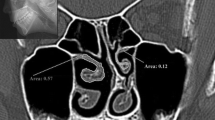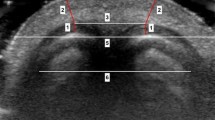Abstract
The aim of this study was to investigate the relationship between the intranasal airway around the turbinates and olfactory function. In total, 32 nostrils of 16 patients who were awaiting septal surgery were involved in this study. For measurements of the volume of the nasal cavity, paranasal sinus computed tomography scans were performed and reconstructed into three-dimensional images. The Butanol Threshold Test and Cross-Cultural Smell Identification Test were used to evaluate olfactory function. The results were analyzed with Pearson’s test. The volume around the turbinates was significantly correlated with the olfactory threshold. However, olfactory identification had no significant correlation with each volume. The airway around the turbinates is very important for nasal airflow and its volume influences olfactory function. Understanding such relationships may help in preserving or improving olfactory function in septal, turbinate or sinus surgery. Further studies are needed regarding the relationships between not only the volume of the nasal cavity and nasal airflow, but also between nasal volume changes and olfactory function.




Similar content being viewed by others
References
Doty RL, Mishra A (2001) Olfaction and its alteration by nasal obstruction, rhinitis, and rhinosinusitis. Laryngoscope 111:409–423
Kern RC (2000) Chronic sinusitis and anosmia: pathologic changes in the olfactory mucosa. Laryngoscope 110:1071–1077
Rombaux P, Duprez T, Hummel T (2009) Olfactory bulb volume in the clinical assessment of olfactory dysfunction. Rhinology 47:3–9
Mueller A, Rodewald A, Reden J, Gerber J, von Kummer R, Hummel T (2005) Reduced olfactory bulb volume in post-traumatic and post-infectious olfactory dysfunction. NeuroReport 16:475–478
Konstantinidis I, Triaridis S, Printza A, Vital V, Ferekidis E, Constantinidis J (2007) Olfactory dysfunction in nasal polyposis: correlation with computed tomography findings. ORL J Otorhinolaryngol Relat Spec 69:226–232
Hornung DE, Leopold DA (1999) Relationship between uninasal anatomy and uninasal olfactory ability. Arch Otolaryngol Head Neck Surg 125:53–58
Damm M, Vent J, Schmidt M, Theissen P, Eckel HE, Lötsch J, Hummel T (2002) Intranasal volume and olfactory function. Chem Senses 27:831–839
Leopold DA (1988) The relationship between nasal anatomy and human olfaction. Laryngoscope 98:1232–1238
Leopold DA, Hummel T, Schwob JE, Hong SC, Kneckt M, Kobal G (2000) Anterior distribution of human olfactory epithelium. Laryngoscope 110:417–421
Kjaergaard T, Cvancarova M, Steinvag SK (2009) Relation of nasal air flow to nasal cavity dimensions. Arch Otolaryngol Head Neck Surg 135:565–570
Hummel T, Mohammadian P, Kobal G (1998) Handedness is a determining factor in lateralized olfactory discrimination. Chem Senses 23:541–544
Zatorre RJ, Jones-Gotman M (1991) Human olfactory discrimination after unilateral frontal or temporal lobectomy. Brain 114:71–84
Hornung DE, Kurtz DB, Bradshaw CB, Seipel DM, Kent PF, Blair DC, Emko P (1998) The olfactory loss that accompanies an HIV infection. Physiol Behav 15:549–556
Jones-Gotman M, Zatorre RJ (1988) Olfactory identification of deficits in patients with focal cerebral excision. Neuropsychologia 26:387–400
Acknowledgement
This work was supported, in part, by grants from the alumni association of the Department of Otorhinolaryngology HNS, the Catholic University of Korea, Seoul, Korea.
Author information
Authors and Affiliations
Corresponding author
Rights and permissions
About this article
Cite this article
Jun, B.C., Song, S.W., Kim, B.G. et al. A comparative analysis of intranasal volume and olfactory function using a three-dimensional reconstruction of paranasal sinus computed tomography, with a focus on the airway around the turbinates. Eur Arch Otorhinolaryngol 267, 1389–1395 (2010). https://doi.org/10.1007/s00405-010-1217-z
Received:
Accepted:
Published:
Issue Date:
DOI: https://doi.org/10.1007/s00405-010-1217-z




